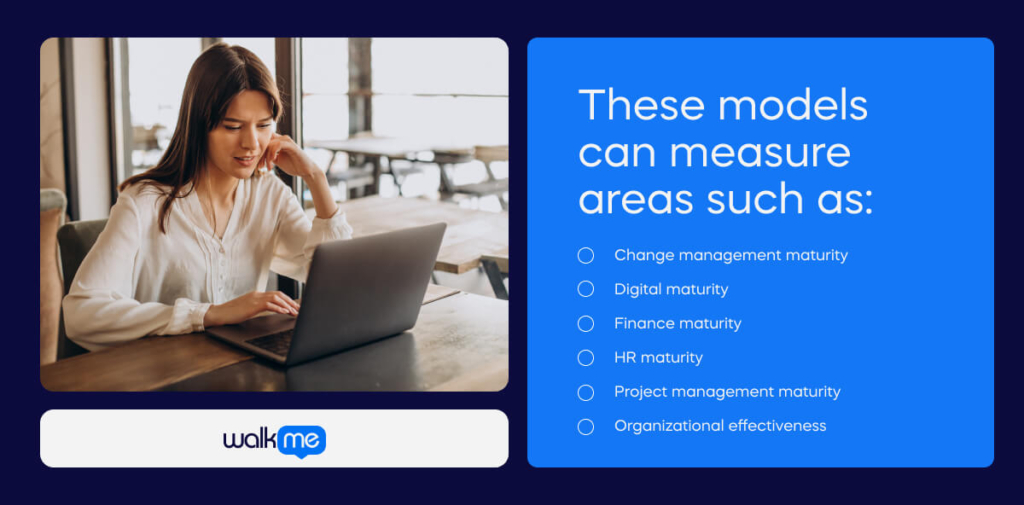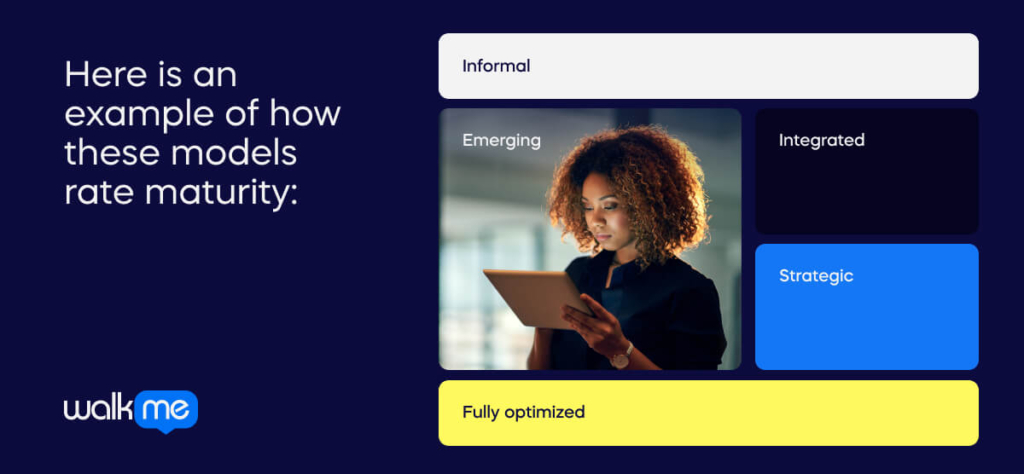An organizational maturity model, a capability maturity model, is a tool that can be used to inform decision-making, offer strategic insights, and much more.
Below, we will learn what an organizational model is, what they are used for, and how they can improve organizational performance.
What Is an Organizational Maturity Model?
In a business context, a maturity model is a tool, such as a scale, describing organizational capabilities.
There is a wide range of maturity models that can be used to assess capabilities in various areas.
These models can measure areas such as:

- Change management maturity
- Digital maturity
- Finance maturity
- HR maturity
- Project management maturity
- Organizational effectiveness
Generally speaking, each maturity model measures a target business function within a scale that trends from least capable to most capable.
Here is an example of how these models rate maturity:

- Informal. At this stage of a maturity model, the organization has little to no capabilities. When new projects or processes are implemented in the discipline in question, teams typically “play it by ear.” Results, therefore, are usually inconsistent and under par.
- Emerging. This level refers to the lowest level of competency. Typically, at this stage, competencies and consistent practices are beginning to emerge, though they are not usually implemented or standardized across the organization.
- Integrated. The third level in many models integrates capabilities, standardized processes, defined best practices, and so forth. Organizations at this level have begun to codify and ensure that best practices are implemented throughout the organization.
- Strategic. At this point, the fourth level of an organizational maturity model, businesses have aligned processes with organizational strategy. These practices are implemented consistently across the organization and managed quantitatively.
- Fully optimized. Business functions that reach the highest and final maturity level have achieved full competency, standardized best practices across the organization, integrated the business function into the organization’s overall strategy, and are undergoing continuous improvement. Fully optimized processes are much more profitable and deliver tangible impacts to the bottom line.
Since virtually any business capability can be measured on such scales, it is no surprise that there are so many maturity models available.
Many of these are designed to assess individual business functions or capabilities, such as change management or specific digital capabilities.
Examples of Digital Organizational Maturity Models
Let’s look at a few examples of digital maturity models to better understand how organizational maturity models are applied in practice.
Generally speaking, digital maturity refers to an organization’s digital capabilities.
However, since “digital capabilities” is such a broad concepts, most models cover specific business activities, such as digital marketing or digital transformation. Though there are a wide variety of models, each with their own scales and stages, the vast majority adhere to the same general framework.
For instance, a digital transformation maturity model created by Justin Grossman, CEO of Meltmedia, consists of four stages that align closely with those covered above:
- Incidental is the lowest level, where digital transformation occurs by accident
- Intentional is the next stage, and at this stage, companies intentionally carry out activities that support digital transformation
- Integrated, the third stage, refers to those companies that strategically implement digital transformation
- Optimized is the final stage, and these are companies that have fully integrated digital transformation into business systems, processes, strategies, and the company culture
Another example of such a specialized digital maturity model is Google’s digital maturity scale.
This scale maps out an organization’s digital marketing maturity in four stages:
- Nascent refers to campaigns that mostly leverage external data and buys, and only have limited links to sales
- Emerging leverages owned data with single-channel optimization and testing
- Connected integrates data across channels and can demonstrate ROI or sales proxies
- Multi-moment executes dynamically across several channels and optimizes toward business outcomes
Another digital maturity model, created by Forrester, the Digital Maturity Model 5.0, consists of four components or dimensions:
- Culture, which should drive innovation and ensure that employees can use digital technology effectively
- Technology, which should be adopted and used fully
- Organization, which should support digital strategy, governance, and execution
- Insights, which determine how well a company can measure and utilize data
These four dimensions, in turn, are used to determine an organization’s digital maturity level. Like the models covered above, Forrester’s model measures digital maturity from least capable to most capable.
Their model consists of four stages:
- Skeptics ignore digital
- Adopters adopt digital, but are stuck using conventional practices
- Collaborators cooperate, but do not fully leverage insights to drive decisions
- Differentiators demonstrate ad hoc excellence
Forrester also includes recommended strategies for each stage. Skeptics, for instance, will need to disrupt their existing practices in order to ascend to the next level.
Final Thoughts
The digital maturity models covered here are only a few of the many organizational maturity models that are in use today.
Companies that are interested in organizational change and business transformation would do well to learn more about these types of models.
For more information on maturity models, read our articles on change management maturity and change management capability.

